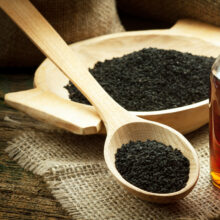Superfoods: Is Turmeric Super Healthy or Super Hype?
- Published: Friday, June 9th 2017
- in Nutrition

Turmeric is the trendy superfood or superroot that makes curries yummy and mustard yellow. It’s been consumed for thousands of years, and is widely used in Ayurvedic medicine. In Indonesia turmeric has been the cornerstone of the herbal medicine system known as Jamu for 4,000 years, taken daily by tens of millions for myriad health/beauty benefits. Jamu is also a popular packaged drink in Southeast Asia and can be found in the U.S. at groceries like Whole Foods.
First, the pros
Fans of turmeric say this root has medicinal properties that may decrease inflammation and headaches, ease the pain of fibromyalgia, and prevent Alzheimer’s disease. Its juice is also used as a beauty ingredient in skin lighteners and masks and turmeric’s anti-inflammatory powers are said to ease eczema, exfoliate dead skin, and reduce signs of aging.
Well-known health expert Dr. Andrew Weil notes that the benefits of turmeric likely stem from its anti-inflammatory properties. He cites a summary of studies published by ethnobotanist James A. Duke, Phd.[1], who concludes that, “ …. turmeric appears to outperform many pharmaceuticals in its effects against several chronic, debilitating diseases, and does so with virtually no adverse side effects.”[2] Weil highlighted these benefits:
Alzheimer’s disease: Turmeric contains natural agents that may block the formation of beta-amyloid, a substance responsible for the plaques that obstruct cerebral function in Alzheimer’s disease.
Arthritis: Turmeric contains more than two-dozen anti-inflammatory compounds, including six different COX-2-inhibitors (the COX-2 enzyme promotes pain, swelling and inflammation).
Cancer: In his summary, Duke noted more than 200 citations for turmeric benefits related to cancers such as colon, prostate and oral.
There are also cautions
Timothy J. Moynihan, M.D., at the Mayo Clinic on Rochester, Minnesota, says that there isn’t enough evidence[3] to prescribe curcuminm, a substance in turmeric, for treating cancer, but notes research is ongoing. Moynihan agrees that curcumin may have antioxidant properties, and may decrease swelling and inflammation, which appear to play a role in some cancers.
According to the University of Pittsburgh Medical Center, large or extended doses of turmeric can cause liver toxicity and stomach upset.[4] Diabetics should be especially cautious, and it may also interfere with blood-thinners such as aspirin or warfarin and affect the blood’s ability to clot.
Should you buy organic?
We think eating organic foods always makes sense. Certified organic turmeric can not be grown with pesticides or be tampered with, and won’t have had curcumin, its healing component, removed. Because turmeric is often grown outside of the U.S., it’s important to be familiar with organic standards in countries like India or Africa. And if you’re considering taking turmeric in a supplement, watch for artificial, synthetic, chemical, and genetically modified ingredients.

Eating turmeric. Yum!
Sauté with spinach, blend in a smoothie, use as a seasoning on roasted vegetables (cauliflower is especially tasty), sprinkle in salad or add to a dressing: turmeric is a delicious addition to a wide range of foods. For a healthy main course, try this protein-packed and gluten-free Four-Spice Quinoa from Spa Eastman.
[1] Alternative & Complementary Therapies, October 2007 and American Botanical Council, HerbClip, July 2008
[2] Andrew Weil, M.D., “Three Reasons to Eat Turmeric”
[3] MayoClinic.org, “Can curcumin slow cancer growth?”
[4] Livestrong.com, “The Risks & Benefits of Taking Turmeric,” July 31, 2011



